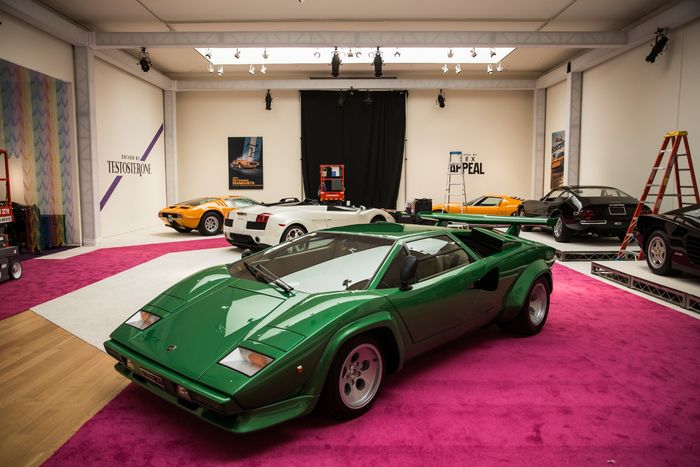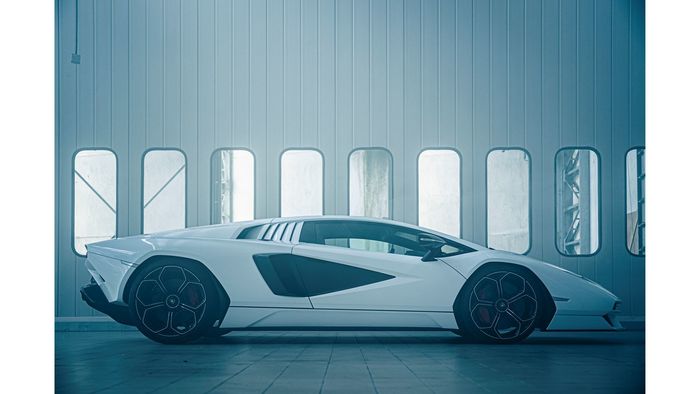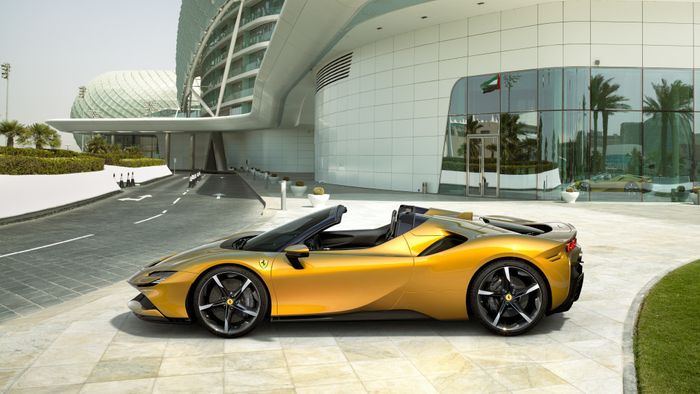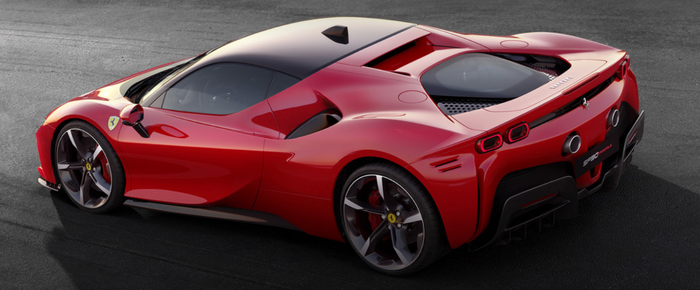The age of electric vehicles has arrived, and even legendary brands are not immune to the inevitable change in the marketplace.
Lamborghini and Ferrari, the Italian makers of supercars known for their roaring gas-powered engines, may have more at stake than mass-market companies including Ford F, +0.62% and Honda HMC, +0.16%. The Italian government is in talks with the European Union to exempt supercar makers from a gas-engine phase-out on the way to electrification.
Still, the two Italian companies are making big leaps in technology. Let’s look at how they’re handling the change in the market.
Lamborghini
Lamborghini’s Countach LPI 800-4 is a successor to the classic Countach, the 1970s-’80s-era car with wild wings and scissor doors that enchanted a generation.
Instead of trying something new with its latest iteration, the Italian supercar maker, which is owned by Volkswagen VWAGY, -2.75% subsidiary Audi, decided to build upon the feature that made the first Countach a legend: a 12-cylinder piston engine.
Here’s the original Countach, this one a 1981 model:

(Photo by Andrew Burton/Getty Images)
And here’s the LPI 800-4:

The LPI designation in the new model stands for Longitudinale Posteriore Ibrido, or Longitudinal Posterior Hybrid in English, and refers to the 6.5-liter engine mounted behind the seating bay. The “hybrid” part is the 48-volt electric motor, which was taken directly from a Lamborghini masterpiece I covered some time ago — the Lamborghini Sián.
The combined horsepower of both systems comes to 802, which, rounded down, creates “800” in the LPI 800-4 moniker. The new Countach can go from 0 to 60 and to 124 mph in 2.8 and 8.6 seconds, respectively, and reach a top speed of 221 mph.
Despite providing only a modest burst in power (33 horsepower of 802 in total), the Countach’s electric motor is still special. Much like Sián’s electric setup, it doesn’t rely on lithium-ion batteries for the “juice.” Instead, it uses so-called supercapacitors.
Unlike batteries, which rely on chemical reactions to release energy, capacitors store static electricity — the kind that builds up on a balloon when you rub it against a shirt. A capacitor can be as simple as two metal plates separated by a thin air buffer.
When an electrical current goes through both plates, a positive charge is created on one plate and a negative charge on the other. The separation between the plates is what makes the capacitor hold on to the energy. This happens almost at the same moment current is applied, which means the capacitor recharges instantly.
Supercapacitors can store more electricity, thanks to a larger plate surface and a shorter distance between the plates. To make them even more energy-efficient, different materials than those in regular capacitors are used. All this makes supercapacitors cheaper and more flexible than lithium batteries.
They’re also much lighter and can fit into the car’s chassis as porous carbon nanotubes. Instead of one massive, flammable battery weighing down the car, the reservoir of energy becomes the chassis itself.
The drivetrain wasn’t the only thing modernized in the new Countach; The exterior and interior were overhauled too. According to Lamborghini CEO Stephan Winkelmann: “It upholds the Lamborghini tradition of looking forward, of exploring new design and technology avenues while celebrating the DNA of our brand.”
The daring, disruptive design that has inspired generations of supercars lives on in this commemorative version. Clean lines, the rear longitudinal positioning of the V12 engine and the iconic scissor doors, now reinterpreted with even sharper edges, make it instantly recognizable and revolutionary at the same time.
The LPI 800-4’s interior is similar to Sián’s, with several notable differences, including a new 8.4-inch infotainment system. Finally, customers can customize everything, from exterior paint colors and interior configurations to stitching.
And now some bad news: Unless you’ve already registered for the new Countach, chances are you’ll probably have to settle for a second-hand vehicle, if you can find one. Only 112 units will be manufactured, and they are already sold out at a price of $2.64 million. Lucky owners will get their hands on this signature hypercar in the first quarter of 2022.
Ferrari
Another automotive icon has decided to dip its toes into the electrified waters of the future: Ferrari’s RACE, -0.54% fastest road car, the Stradale, now comes with a plug. It’s a hybrid, like Lamborghini’s model, but unlike the LPI 800-4, Stradale needs to be plugged in to recharge its battery.
The SF90 Stradale boasts blazing acceleration via a total of 986 horsepower, thanks to its 90-degree twin-turbo V8 engine, which has 769 hp, and an additional 217 hp from three electric motors. One is located between the engine and the new eight-speed dual-clutch transmission on the rear axle, and two on the front axle. The car’s engine control unit (ECU) continually shifts between the modes to optimize power and efficiency. The hybrid system’s efficiency is further maximized with Ferrari’s latest off-the-shelf hardware and intelligent software.
A high-performance 6.5 kilowatt-hour (kWh) li-ion battery gives off enough energy to enable all-electric mode for 25 kilometers (15.5 miles) and a top speed of 135 km/h. Although Ferrari envisioned this mode for reverse driving and traversing cityscapes, a typical Ferrari owner wouldn’t buy this iconic hypercar just to go grocery shopping.
Still, finding roads where Stradale can fully spread its wings is not an easy task. With a top speed of 211 mph and acceleration to 62 and 124 mph in 2.5 seconds and 6.7 seconds, respectively, SF90 is the fastest car on the Fiorano Circuit (a private race track owned by Ferrari) — even faster than the ferocious LaFerrari. To achieve these speeds, a driver would use the Qualify driving mode, which uses the powertrain to its full potential.
Ferrari’s website says of the design: “The definition of the exterior styling was inspired by [a] principle: to create a forward-looking, innovative design that transmits the car’s mission as an extreme sports car. …”
Here are two photos, the first showing the new model in convertible, or Spider, trim:


The chassis of SF90 Stradale combines aluminum and carbon fiber to be light and sturdy in addition to looking good.
The design serves a functional purpose. A specially optimized twin-part rear wing, forged wheels and a complex system of vortex generators mounted at the front enable SF90 to generate 390 kilograms (860 pounds) of downforce at 250 km/h (155 mph).
Inside, Ferrari designers implemented a captivating 16-inch curved display with all the vital stats you need, as well as a new heads-up display that shows contextual information based on the driving mode of your choice.
The steering wheel may resemble that of an older model, but the new technology has found a way to shine through in the form of capacitive touch interfaces. Ferrari has decided to leave a multitude of other conventional levers and buttons purely analog to retain a certain look and feel. And, yes, this also means channeling the growl of the Ferrari engine into the cockpit.
Unlike Lamborghini’s LPI 800-4, SF90 has a “modest” starting price of $500,000, and is a series production vehicle. If you can afford it, chances are you’ll be able to get your hands on one.
Future of hypercars
Lamborghini and Ferrari have made amazing vehicles that are sure to please both old and new hypercar lovers. Until manufacturers go fully electric, these cars should be seen as transient models, a good middle ground for those who want a powerful engine (and a recognizable sound) as well as additional boost generated by electric power.
Which one of these do you prefer? Let me know in the comment section below.





